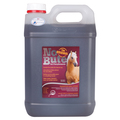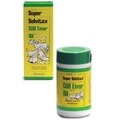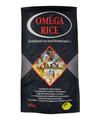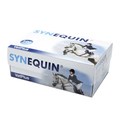Kissing Spines is the laymans term for overriding or impinging dorsal spinous processes in the horse. The dorsal spinous processes (DSPs) protrude vertically from the vertebrae and run from the withers to the pelvis. In a normal spine the DPS's are regularly spaced with a sufficient gap in between them. In a horse with kissing spines the gaps are reduced and the DSP's may be touching causing pain. In severe cases they may even be fused.
Horses of any age or breed can develop kissing spines although they tend to be seen more often in performance horses in a high level of work such as eventing, showjumping, dressage or racing. Clinical signs include pain on palpation of the back, resentment to the saddle going on or girth being done up. However there are often very unspecific signs such as not wanting to go forward or work in an outline, refusing to jump, bucking, bolting and becoming disunited in canter. It is also possible for a horse to have kissing spines without showing any clinical signs at all.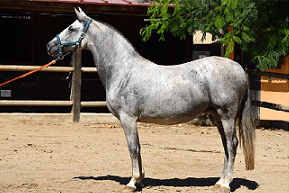 Diagnosis is relatively easy using radiography as most horses with kissing spines will have obvious changes on x-ray. However the degree of pain shown by the horse does not necessarily correlate with the severity of changes on the x-ray. Of course it is possible that changes shown on an x-ray happened months or years earlier and are not currently causing a problem. For this reason or where x-rays are inconclusive your vet may recommend a bone scan. A bone scan will highlight active areas of remodelling so can help confirm a diagnosis of kissing spines and show any concurrent problems which are often seen with kissing spines. It is thought that certain areas are overloaded as a result of guarding the back or vice versa. To verify any changes on x-ray or bone scan your vet may then inject local anaesthetic around the DPS's in question to numb the area. The horse is trotted up, lunged and/or ridden before and after the block and any improvements or changes noted. However this stage is not always necessary if the vet is confident of the diagnosis. Kissing spines can be treated both medically and surgically. Medical treatment includes injecting anti-inflammatory steroid into the affected areas of the back. This treatment is effective in many horses but is really just giving pain relief rather than treating the underlying condition. Tildren has more recently been given successfully. The mechanism of which is to prevent lysis and destruction of bone surfaces and promotes healthy new bone growth. Shockwave therapy may also be performed concurrently which works well for some horses.
Diagnosis is relatively easy using radiography as most horses with kissing spines will have obvious changes on x-ray. However the degree of pain shown by the horse does not necessarily correlate with the severity of changes on the x-ray. Of course it is possible that changes shown on an x-ray happened months or years earlier and are not currently causing a problem. For this reason or where x-rays are inconclusive your vet may recommend a bone scan. A bone scan will highlight active areas of remodelling so can help confirm a diagnosis of kissing spines and show any concurrent problems which are often seen with kissing spines. It is thought that certain areas are overloaded as a result of guarding the back or vice versa. To verify any changes on x-ray or bone scan your vet may then inject local anaesthetic around the DPS's in question to numb the area. The horse is trotted up, lunged and/or ridden before and after the block and any improvements or changes noted. However this stage is not always necessary if the vet is confident of the diagnosis. Kissing spines can be treated both medically and surgically. Medical treatment includes injecting anti-inflammatory steroid into the affected areas of the back. This treatment is effective in many horses but is really just giving pain relief rather than treating the underlying condition. Tildren has more recently been given successfully. The mechanism of which is to prevent lysis and destruction of bone surfaces and promotes healthy new bone growth. Shockwave therapy may also be performed concurrently which works well for some horses.
Surgical treatment can involve two different surgeries. The first and older of the two surgeries is a Dorsal Spinous Process Resection. This surgery entails removing the affected DSP, or every other DSP where there is more than one or two affected, to create space between the processes. A newer surgery is Interspinous Ligament Transection which does not remove any bone but cuts the interspinous ligament between the affected processes. This releases the tension on the nerve endings where the ISL joins the bone and creates more space stopping the processes from rubbing against each other.
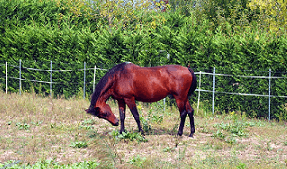 This surgery has been very successful in many cases and is often the preferred option. However some horses will have severe kissing spines that still require DSP resection. These days both surgeries tend to be done with the horse standing under sedation to reduce bleeding and the risks associated with general anaesthetics. Following surgery the horse may need up to 3 months off ridden work depending on the individual horse and how many processes were affected.
This surgery has been very successful in many cases and is often the preferred option. However some horses will have severe kissing spines that still require DSP resection. These days both surgeries tend to be done with the horse standing under sedation to reduce bleeding and the risks associated with general anaesthetics. Following surgery the horse may need up to 3 months off ridden work depending on the individual horse and how many processes were affected.
The horses back muscles often go into spasm and so with either medical or surgical treatment it is important to include good physiotherapy and rehab. Exercises that build core strength and raise the back such as lunge work with an Equi Ami or Pessoa are very beneficial. A correctly fitting saddle is also essential.
Many horses do return to their original level of work following kissing spine surgery or continue to do well with medical management. Some may not but will usually show some improvement. 
Written by: Dr. Sophie Meers BVSc MRCVS

